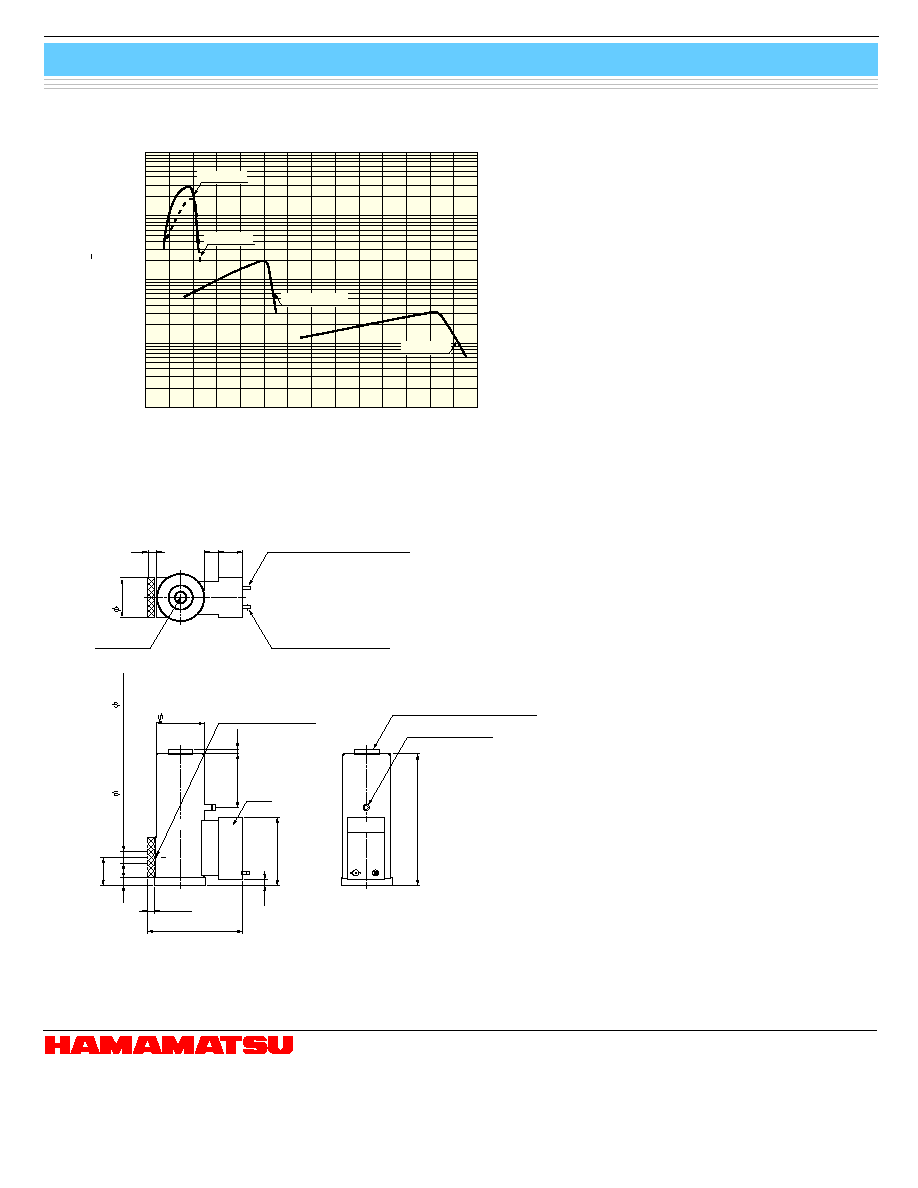
These devices combine a dewar type detector with a compatible preamplifier, and easily operate to detect infrared radiation just by connecting to
a DC power supply. InGaAs, InSb and MCT (HgCdTe) detectors are provided as standard devices (liquid nitrogen cooling). Custom-designed
devices with different active areas, FOV or amplifier gain, etc. are also available to meet your specific needs.
Features
l Compact integral detector unit
l Optimum connections between the detector element and pre-
amplifier allow amplified signals to be easily obtained.
Applications
l Infrared detection
I N F R A R E D D E T E C T O R
Infrared detector module with preamp
High sensitivity modules of easy-to-use
Metal dewar type
Accessories (Optional)
l Power supply for preamplifier (±15 V)
C3871
Accessories (Supplied)
l 4-conductor cable (for DC power supply):
2 m (connector installed at one end)
A4372-02
l BNC-BNC coaxial cable (for signal output): 2 m
E2573
l Instruction manual
s Specifications / Absolute maximum ratings
Absolute maximum ratings
Active area
External input
voltage
External input
voltage
Operating
temperature
Topr
Storage
temperature
Tstg
Type No.
Detector element
(mm)
(V)
(V)
(∞C)
(∞C)
G7754-01
1
G7754-03
InGaAs
3
P7751-01
0.6
P7751-02
InSb
2
±Vs *
1
P7752-10
MCT
1 ◊ 1
±15
±18
0 to +40
-20 to +50
*1: Vs=12 to 15 V
s Electrical and optical characteristics (Typ.)
M e as ure me nt
condition
Element
te m p er ature
T
Peak
sensitivity
wavelength
p
Cut-off
wavelength
c
Photo
sensitivity
S
=p
NEP
Frequency
response
-3 dB
Output
impedance
Maximum
output
voltage
R
L
=1 k
Maximum
current
consumption *
2
Type No.
(∞C)
(µm)
(µm)
(V/W)
(W/Hz
1/2
)
(Hz)
(
)
(V)
(mA)
G7754-01
2 ◊ 10
9
3 ◊ 10
-14
2 to 500
±10
±15
G7754-03
2.0
2.4
5 ◊ 10
8
1.5 ◊ 10
-13
2 to 500
±10
±15
P7751-01
3 ◊ 10
8
3 ◊ 10
-13
5 to 10000
±10
±20
P7751-02
5.3
5.5
1.5 ◊ 10
8
1 ◊ 10
-12
5 to 12000
±10
±20
P7752-10
-196
12
14
2 ◊ 10
6
3 ◊ 10
-12
5 to 140000
50
±3
+60, -10
*2: Vs=15 V
1

Infrared detector module with preamp
Metal dewar type
HAMAMATSU PHOTONICS K.K., Solid State Division
1126-1 Ichino-cho, Hamamatsu City, 435-8558 Japan, Telephone: (81) 053-434-3311, Fax: (81) 053-434-5184, http://www.hamamatsu.com
U.S.A.: Hamamatsu Corporation: 360 Foothill Road, P.O.Box 6910, Bridgewater, N.J. 08807-0910, U.S.A., Telephone: (1) 908-231-0960, Fax: (1) 908-231-1218
Germany: Hamamatsu Photonics Deutschland GmbH: Arzbergerstr. 10, D-82211 Herrsching am Ammersee, Germany, Telephone: (49) 08152-3750, Fax: (49) 08152-2658
France: Hamamatsu Photonics France S.A.R.L.: 8, Rue du Saule Trapu, Parc du Moulin de Massy, 91882 Massy Cedex, France, Telephone: 33-(1) 69 53 71 00, Fax: 33-(1) 69 53 71 10
United Kingdom: Hamamatsu Photonics UK Limited: 2 Howard Court, 10 Tewin Road, Welwyn Garden City, Hertfordshire AL7 1BW, United Kingdom, Telephone: (44) 1707-294888, Fax: (44) 1707-325777
North Europe: Hamamatsu Photonics Norden AB: Smidesv‰gen 12, SE-171 41 Solna, Sweden, Telephone: (46) 8-509-031-00, Fax: (46) 8-509-031-01
Italy: Hamamatsu Photonics Italia S.R.L.: Strada della Moia, 1/E, 20020 Arese, (Milano), Italy, Telephone: (39) 02-935-81-733, Fax: (39) 02-935-81-741
Information furnished by HAMAMATSU is believed to be reliable. However, no responsibility is assumed for possible inaccuracies or omissions.
Specifications are subject to change without notice. No patent rights are granted to any of the circuits described herein. ©2001 Hamamatsu Photonics K.K.
Cat. No. KIRD1024E02
Nov. 2001 DN
WAVELENGTH (µm)
10
9
0
10
10
10
12
10
11
10
13
1
2
3
4
5
6
7
8
9
10
11
12
13
(Typ. T= -196 ∞C)
14
D
*
(cm ∑ Hz
/W)
1
2
G7754-01
P7751-01/-02
P7752-10
G7754-03
11
LN
2
FILL PORT
AMP
8.6 ± 1
125.5 ± 1
51.2
70.0
6.5
18 32
37
± 0.5
10
WINDOW 16 (MCT ONLY: 13.5)
63.5 ± 1
89.5
8.5
172
± 1
SIGNAL OUTPUT (BNC)
DC INPUT VOLTAGE
±15 V (4-PIN CONNECTOR)
FOAM POLYSTYRENE PLUG
PUMP-OUT PIPE
49
PHOTOSENSITIVE
SURFACE
KIRDA0010EB
s Spectral response
KIRDB0076EC
s Dimensional outline (unit: mm)
s Precaution for use
∑ The detector should not be placed horizontally during use.
∑ Using these detectors in an environment subjected to vibration may cause microphonic noise. Take measures to prevent
vibration as needed.
2

